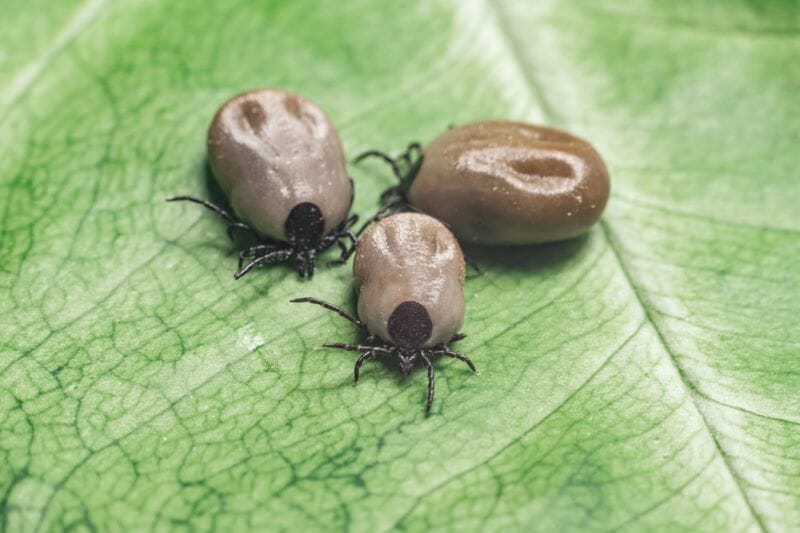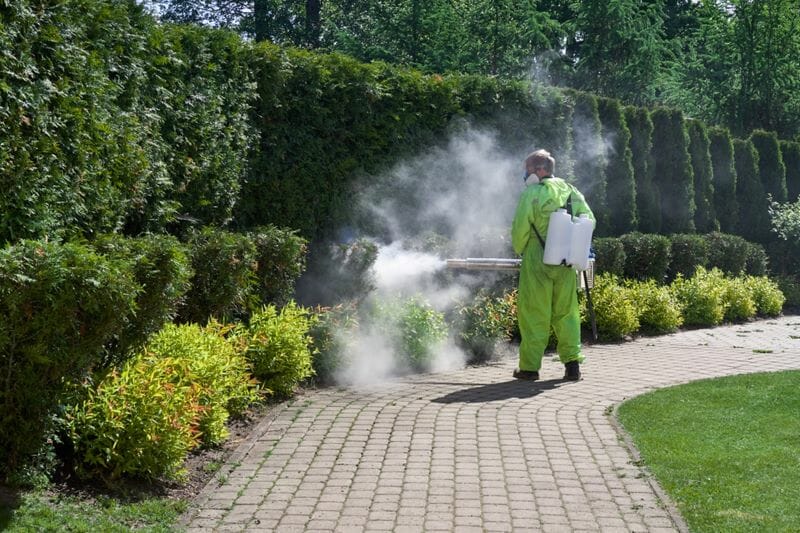Ticks: the very sight of them is enough to make most people cringe.
Unfortunately, these tiny, blood-sucking pests are common throughout the US, and many species are more than happy to set up shop in your yard.
If you’ve found ticks on your property, getting rid of them is probably your top priority.
In addition to being unsettling to look at, ticks transmit a variety of diseases, including Lyme disease, Rocky Mountain spotted fever, tularemia, and more.
Fortunately, there are effective ways to get rid of fleas and ticks without making your yard into a war zone. Even better, many treatments that kill ticks will also kill fleas, chiggers, and other backyard pests.
Here at Smith’s Pest Management, we provide tick control services to help San Francisco Bay Area homeowners get rid of ticks in their yards. In this blog, we’re sharing our tips and tricks.
Key Takeaways
- Ticks usually enter your yard via deer or small rodents, like mice and rats. They hide in areas full of tall grass, moist dirt, and shade.
- Get rid of ticks in your yard with home remedies like cedar oil spray, eucalyptus or neem oil, or diatomaceous earth. Conventional methods like tick foggers, permethrin yard spray, and acaricides can also be effective.
- Need help determining if you have ticks in your yard? Try tick-dragging with a light-colored sheet or towel, check your pets, and use a flashlight to spot ticks along rocky or densely vegetated lawn areas.
What are Ticks?

While many people think ticks are insects, they’re actually arachnids – in the same family as scorpions, mites, and spiders. There are many different varieties of ticks in the US, many of which carry diseases.
Wondering how to identify ticks?
Different species of ticks can be gray, white, brown, black, reddish-brown, or even yellow in color. Adults have flat, oval-shaped, wingless bodies.
When ticks have a blood meal, their bodies will swell and become round, like a kernel of corn. While nymphs and adult ticks have eight legs, tick larvae only have six.
As larvae, ticks are about the size of a grain of sand. Ticks can bite humans and animals at all stages of their life cycles.
Why is My Yard Full of Ticks?
What causes ticks in a yard?
The answer is it depends.
Deer can bring ticks to your yard, as can small rodents.
Once they’re in your yard, ticks will find an ideal habitat to establish themselves. All species of ticks love darkness and moisture.
Their favorite hiding spots include areas that offer tall grass, moist dirt, and plenty of shade.
If your yard is mowed, ticks may still establish themselves in the outer areas, where they can find low-hanging shrubs or ground cover plants to use as shelter.
How do I Know if My Yard Has Ticks?

Many people assume that, because they have deer in their yard, they also have ticks. There’s no way to know if ticks are present, though, unless you test for them.
Fortunately, there are a few simple ways to figure out if you have ticks in your yard:
1. Tick dragging
Here’s how to do it:
Grab a light-colored sheet or towel and drag it through the yard.
Once you’ve pulled the sheet through the yard, take it to a grass-free area, like a driveway, and inspect it carefully for ticks. If you find ticks, place them in a sealed Ziploc bag and destroy them.
2. Check your pets
Another way to identify ticks in your yard is to check your pets after they come inside. If you find ticks on your outdoor pets, there’s a good chance they’re picking the ticks up in your yard.
To check pets for ticks, the CDC recommends running fingers through their hair and using gentle pressure to check for any bumps.
A tick will feel like a hard, small mass.
3. Use a flashlight to spot ticks
You can also check the yard for ticks manually. Using a flashlight, inspect the following locations for signs of ticks:
- Along rock, brick, or retaining walls.
- In areas of dense or tall brush or grass.
- In piles of yard debris, including leaf piles and firewood piles.
- Places where your pets spend time, like dog houses or outdoor kennels.
- In trees or landscaping bushes.
- In areas where leaf or other organic debris have collected.
How to Get Rid of Ticks in the Yard
With Natural Remedies

Nobody wants ticks in their yard, but how do you get rid of them? Luckily, there are many effective natural home remedies that are safe for dogs and other pets, and effective at deterring ticks.
Here’s what we recommend:
1. Cedar oil spray
One of our favorite natural tick repellents is cedar oil spray. Cedar oil is a natural, non-toxic, effective tick repellent. If you’re going out hiking, you can spray it directly on your skin or clothing.
It’s safe for use on humans and pets.
While you can buy cedar oil tick spray at most home and garden stores, you can also make your own by mixing 60 drops of cedarwood essential oil into a dark-colored spray bottle filled with water and 1 ounce of grain alcohol.
Shake the mixture well and spray anywhere you’ve noticed tick activity.
2. Eucalyptus or neem oil
Both eucalyptus and neem oil will kill ticks on contact.
To use these essential oils to get rid of ticks, combine 4 ounces of purified water into a spray bottle, along with 30 drops of your carrier oil of choice. Shake well and spray anywhere you want to kill ticks.
3. Diatomaceous earth
What kills ticks in the yard naturally?
Diatomaceous earth (DE) is a powder made from fossilized diatoms and is one of the most effective ways to get rid of pests organically.
While it’s completely safe for kids, pets, and people, DE is dangerous for pests.
When ticks encounter DE, it will dehydrate them immediately, killing them within hours.
To use DE as a tick-killer, sprinkle it anywhere you’ve noticed ticks in your yard. You can also use it to create a barrier between wooded and grassy areas.
Re-apply the DE every few weeks, or after heavy rain.
With Chemicals

If you want to take a more hard-handed approach to ticks, try these conventional options:
1. Fogger
If you want an option that instantly kills ticks, you can consider a yard fogger.
EPA-registered foggers will kill fleas, flea eggs, ticks, lice, mites, and other pests. For best results, look for a fogger that includes an insecticide formulated specifically for ticks, as this will work fastest and most efficiently.
2. Permethrin yard spray
When it comes to pesticides, permethrin is one of the most effective at killing ticks.
For best results, choose a permethrin insecticide spray that’s safe to apply to the surfaces and plants you want to target. Read the product label closely, and make sure to wear protective clothing as you apply.
3. Acaricides
Acaricides are a family of tick pesticides that the CDC says can reduce the number of ticks in your yard. While they won’t get rid of ticks on their own, they can be effective when combined with other tick control methods.
Because acaricides can be dangerous and highly toxic, we recommend working with a professional pest management company, like Smith’s, to apply the pesticides and keep kids, pets, and other animals safe in the process.
How do Pest Control Experts Get Rid of Ticks?
When you hire a tick control expert, you expect great results.
Here’s the process that the team at Smith’s Pest Management follows to get rid of ticks on large properties and small yards alike:
1. Tick inspection
When you contact Smith’s Pest Management, we’ll send a trained, certified pest control technician to perform a thorough tick inspection.
We’ll evaluate your property for any signs of tick activity, and work with you to determine where ticks might be coming from, and why they’re so attracted to your yard.
We’ll also sample areas around your home and property to identify the presence of other organisms that could be serving as hosts for ticks, such as small rodents.
2. Treatment
Once we’ve completed our tick inspection, we’ll begin our treatment regimen.
Depending on the severity of your tick infestation, these treatments may include the use of backpack sprayers, liquid residual products, power sprayers, and more.
We’ll apply a customized mix of granular products, dust, aerosols, and liquid residual products, making sure to focus on the exterior of your home and the span of your yard.
These treatments will eliminate ticks on contact, and help you reclaim your tick-free yard.
3. Follow-up treatments
Once we’ve delivered your primary treatment, we’ll schedule needed follow-up treatments to help your yard stay tick-free.
We’ll build a treatment timeline around your schedule and continue monitoring your property’s tick levels to ensure a pest-free outdoor space.
How to Keep Ticks out of Your Yard

It’s important to take preventative action to keep ticks out of your yard, and away from your pets and family. Here are the simple tricks we recommend”
1. Get rid of other pests
Pests like raccoons, rats, mice, squirrels, and other rodents can introduce pests into your yard. To get rid of ticks, it’s important to address these underlying infestations, as well.
Mark areas where you’ve seen mice or other pests and hire a pest management team like Smith’s to help you get rid of pests at the source.
2. Practice good yard hygiene
Ticks love to hide in dark, sheltered places like wood piles, leaf piles, and scrub brushes. With this in mind, follow these tips to make your yard uninhabitable for them:
- Get rid of any yard debris. If you rake leaves in the fall, avoid leaving piles sitting around. instead, bag them in leaf bags and dispose of them properly. If you burn firewood for heat, keep it stacked neatly in a dry area. This keeps rodents away and prevents them from carrying ticks into your yard. Finally, get rid of any old furniture, trash, or organic matter in your yard, which could be giving ticks a place to hide.
- Maintain your lawn. Cut your grass regularly, remove tall grasses or shrubs, and be sure to pick up all grass cuttings promptly.
- Create a barrier. Keep all playground equipment, patios, and decks at least 8 feet from the edge of your lawn.
- Construct fences. Use tall fences to keep deer, raccoons, and stray dogs from entering your yard and bringing ticks with them.
3. Create a barrier
The CDC recommends keeping a 3-foot barrier of gravel or wood chips between wooded areas and laws to make it harder for ticks to migrate into recreational areas.
4. Plant tick-repellent landscaping plants
Some landscaping plants repel ticks. Garlic, sage, mint, lavender, rosemary, marigold, and beautyberry are some of the most effective tick-deterrent plants.
For best results, plant these varieties in landscaping borders, around decks and pet runs, around patios, and anywhere else you’d like to keep ticks away from.
You can also put these varieties in containers and place them near windows to discourage ticks from entering your home.
Are Ticks Invading Your San Francisco Bay Area Yard? We’re Here to Help!
If ticks are taking over your property, you don’t have to grin and bear it. Here at Smith’s Pest Management, we help homeowners just like you get rid of ticks on their property.






